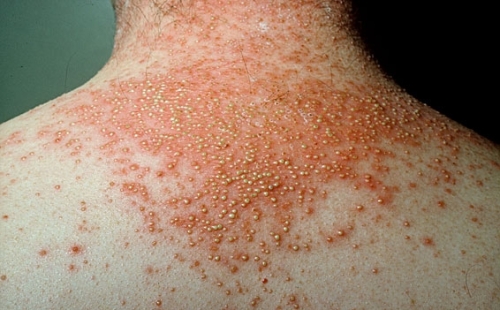Pustular psoriasis is a rare form of psoriasis. It appears as well demarcated, raisedbumps surrounded by reddish area. These raised projections are filled with white and thick fluid composed of white cells known as pus. Under and around these projections, the skin appears erythematous. Acute pustular cutaneous characteristics may occur before, after or during psoriasis vulgaris episodes.
Forms of Pustular Psoriasis
The forms of pustular psoriasis are classified on the basis of clinical course. It is classified into following types:
- Acute
- Sub-acute
- Chronic
- Acute form: It is also known as Von Zumbusch variant. It is usually accompanied by toxicity and fever. Proper management and treatment should be taken during acute phase otherwise it can prove to be lethal.
- Sub-acute or chronic phase: It is milder form of pustular psoriasis. Less systematic infections are there. It is described as annular or circunate type of lesion.
- Juvenile or infantile form: This is another type of pustular psoriasis. But it is rare form.
Cause of Pustular Psoriasis
The main aetiology of pustular psoriasis is Enhanced polymorphonuclear leukocyte (PMNL) chemo taxis. This is due to intrinsic defect or due to the presence of chemo attractants in the epidermis. But still, the research is yet to be conducted to know the principal stimulus for the migration of PMNL to the epidermis. Some researchers also emphasis the role of cytokines secreted by keratinocytes in PMNL migration.
Predisposing factors of Pustular Psoriasis
The following risk factors can predisposed the development of this disease:
- Topical steroids: use of strong and irritating topicals like zinc pyrithione, tar, anthralinetc. can predispose to the eruption of pustular psoriasis.
- Cholestatic jaundice: this is also one of the predisposing factors leading to the development of this disease.
- Infections: infection on the epidermis can also invite PMNL to the surface thus leading to pustular psoriasis.
- Drug allergy: use of certain drugs like trazodone, phenylbutazone, iodine, salicylates
- Hypocalcaemia: less amount of calcium in the body can also lead to pustular psoriasis eruption
- Idiopathic
Symptoms of Pustular Psoriasis
These are the symptoms of Pustular Psoriasis
- Headache, chills, fever, nausea
- Skin becomes inflamed and fiery red
- Appearance of clusters of superficial pustules of 2-3 mm size
- Coalescing of pustules and formation of pus lakes
- Formation of smooth and erythematous surface after pus gets dry out
- Episodes of pustulation occurs for few days
- Systematic involvement with in few days in severe cases
Treatment of Pustular Psoriasis
These are the treatment which helps in curing the Pustular Psoriasis
- Supportive measure: Patients suffering from pustular psoriasis eruption should be admitted to the hospital for proper treatment and care.
- Adequate hydration,avoidance of excessive heat lossbed rest should be ensured.
- Use of bland topical compresses or oatmeal baths should be done which will help in debriding and soothing affected areas. This topical strategy is also effective in many paediatric patients as well.
- Pharmacological treatment: it should be started along with supportive measures. Oral retinoids, cyclosporine, hydroxyurea, 6-thioguanine and methotrexate are considered as first line treatment for pustular psoriasis.
- Phototherapy: following phototherapy treatment are useful for the severe stages of pustular psoriasis.
- Oral psoralen plus UV-A
- UV-B and narrow-band UV-B
- Retinoid plus PUVA

